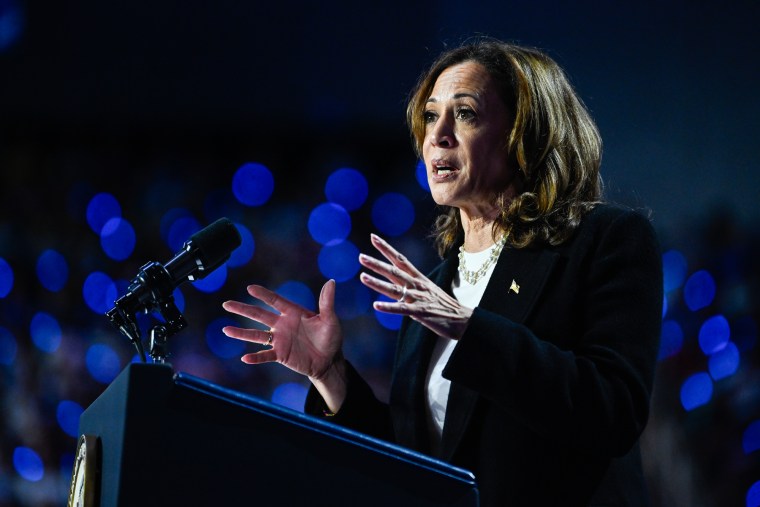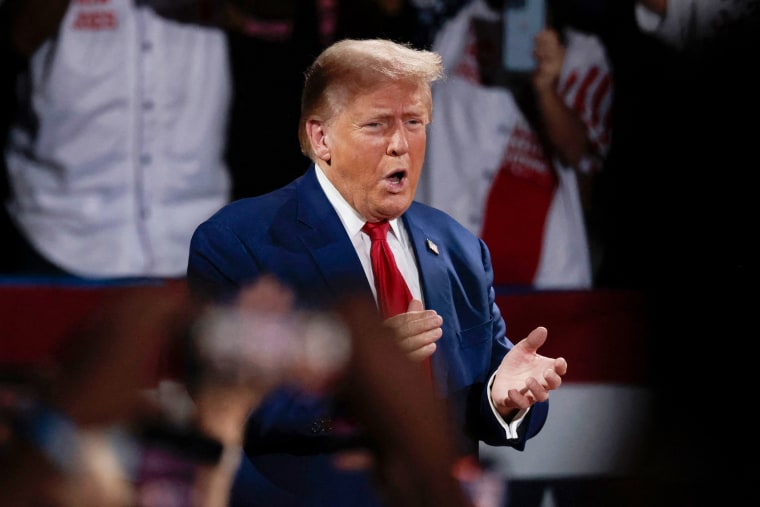
WASHINGTON — As president, Donald Trump slashed a lucrative tax break enjoyed by coastal donors and suburban swing-state voters. Now, he’s promising to give back the deduction — if only they will put him back in the Oval Office.
Trump aides say that he isn’t ransoming a hostage, or even flip-flopping on the $10,000 annual limit he placed on the federal deduction taxpayers can claim based on their state and local taxes — the “SALT cap” in Washington talk. Instead, one campaign official said, Trump is responding to new economic realities as he pursues a “two track” solution. The first is promoting pro-growth policies, and the second is adopting tax positions that would allow Americans to keep more of their money.
What shifted more than the economy is Trump’s needs, said Caroline Bruckner, managing director of American University’s Kogod Tax Policy Center.
“The change in the limitation on the deductibility of state and local taxes was an easy play to target revenue flowing to blue states,” Bruckner said of the 2017 law, which used the SALT cap as a budget offset to pay for other tax cuts. “Now it appears that higher income taxpayers in swing states have been able to successfully plead their case to Trump.”
The reversal is one of a flurry of freebies that Trump and his rival, Vice President Kamala Harris, are offering voters in the stretch run before Election Day. Together, they are promising the equivalent of a tax break in every pot.

Both candidates vow to block taxes on tips for service-industry workers. Trump says he’ll spare seniors from taxes on Social Security payouts. Harris is pumping steroids into Biden administration proposals to expand the child tax credit and subsidize first-time homebuyers. She’s also offering a deduction of up to $50,000 in the first year for small business start-ups.
There are big-spending promises, too, like Trump’s announcement — the details of which remain to be fleshed out — that he will provide free in-vitro fertilization treatments for people who are trying to conceive.
“It’s the silly season, when everything is free,” said former Rep. Charlie Dent, R-Pa., who was a leader among GOP moderates in Congress.
“This is really one of the great challenges in the country right now, that there needs to be a serious conversation about some type of fiscal restraint,” Dent said. “These kinds of proposals are just meant to pander at audiences. I can’t imagine any of these things we just listed are ever going to become law, but they make for good commercials, and they certainly raise expectations for people, and, at the end of the day, really disappoint a lot of people and drive cynicism.”

Each plum or carve-out appeals to a different segment of the electorate. They would all add to annual federal deficits — and the $35 trillion-plus accumulated national debt — if they could be implemented. But none of them would have an easy path to enactment.
“Given the magnitude of our debt problems, I wish the candidates were competing over who could reduce the debt and save Social Security,” said Marc Goldwein, a senior vice president at the non-partisan Committee for a Responsible Federal Budget. “Instead, they seem to be competing over who can spend more of our grandkids’ money.”
In other words, this ice-cream-for-every-meal portion of the campaign threatens to blow a hole in the budget.
While Goldwein’s group is still working on a comprehensive analysis of the fiscal impacts of the two candidates’ platforms, the outlines are dark with red ink. Trump’s proposal to repeal the SALT cap, which is set to expire next year if Congress takes no action, would reduce federal revenue by $1.2 trillion over a decade, according to CRFB’s estimate.
Harris has unveiled proposals that would raise taxes on corporations, investors and high-end earners in ways that could result in a net reduction in deficits and debt — at least on paper — according to an analysis by the non-partisan Tax Foundation. But it may be more politically feasible for a President Harris to cut taxes, like the $1.6 trillion it would cost to reinstate the child tax credit and expand it to $6,000 for the first year of a kid’s life, than to raise them.
“Neither candidate is talking about substantial ways to reduce the deficit,” Goldwein said. “It seems like they’re both going to be in the red and especially President Trump.”
Harris’ camp points to her efforts to offset the costs of some of her promises — and to Trump’s failure to do so.
“Donald Trump won’t pay for his agenda, but the middle class will: with higher costs, cuts to Social Security and Medicare, and less economic opportunity,” Harris campaign spokesman James Singer said. “Vice President Harris will make billionaires and big corporations pay their fair share while she builds up the middle class and creates an opportunity economy where everyone has the chance to compete and a chance to succeed.”
And yet, there are reasons to doubt Harris’ ability to pay for her platform.
One of Harris’ marquee proposals is to begin taxing paper gains on wealthy investors’ assets before they are sold — an “unrealized gains” levy that is part of a broader plan to create a 25 % minimum tax on all income for people who earn more than $100 million in a year. Like many of the policies Harris has unveiled since she became the Democratic nominee, it closely tracks provisions of President Joe Biden’s agenda that have never gained traction.
“Every conversation I’ve had is that it’s not going to happen,” billionaire Mark Cuban, a Harris supporter, said in an interview with CNBC earlier this month. “If you tax unrealized gains, you’re going to kill the stock market.”
Trump’s U-turn on the SALT cap raised eyebrows in both parties because it paid for a substantial portion of his signature 2017 tax cut — and because the repeal he’s now endorsing would help many blue-state voters at the expense of red-state voters.
But, from an electoral politics perspective, that may be the point. He can afford to upset voters in certain low-tax states — many in the Deep South — where he is likely to win by overwhelming margins. No one thinks the plan will push Republicans in states like South Carolina and Mississippi to vote for Harris.
But the tax giveaway could help attract donations at a time when his campaign is desperate to keep up with the flood of cash that has flowed into Harris’ coffers. The top ten list of counties with the highest average reported state-and-local tax burden for filers who itemize deductions are all in donor havens, according to data collected by the Tax Foundation and analyzed by NBC News.
They are: Manhattan; three counties encompassing San Francisco and Silicon Valley; the counties containing the toniest western resorts — Sun Valley, Idaho, Aspen, Colorado and Jackson Hole, Wyoming; and the high-end suburbs of Westchester County, New York, and Fairfield County, Connecticut.
Perhaps more important is the smaller but noticeable effect the plan would have on suburban voters, including those in swing states. In Maricopa County, Arizona’s largest, Trump lost by 2.2 percentage points in 2020 on his way to an even smaller defeat statewide. The average deduction-itemizing tax filer in the county reported state and local taxes of $14,083, according to the Tax Foundation — about $4,000 above the Trump-enacted cap on deductions.
Trump got smoked in the suburban counties around Philadelphia in 2020, in part because Biden — who is from nearby Wilmington, Delaware — is a familiar presence in local media. But many voters in those counties would stand to benefit considerably from a repeal of the SALT cap. The average itemizing taxpayer in each of those counties — Montgomery, Chester and Delaware — reported state and local taxes of about double the cap. The same was true for Pittsburgh’s Allegheny County, in the western part of the state.
“The collar counties of Philadelphia, where you do have pretty high property taxes, you know, it makes a difference,” Dent said, adding that it might make more sense to raise the cap a little bit — and index it — than to eliminate it.
“You could protect more middle-income, upper-middle income people who could be negatively impacted” that way, Dent continued, without slashing federal revenue to shield the wealthiest taxpayers.
 Print
Print


